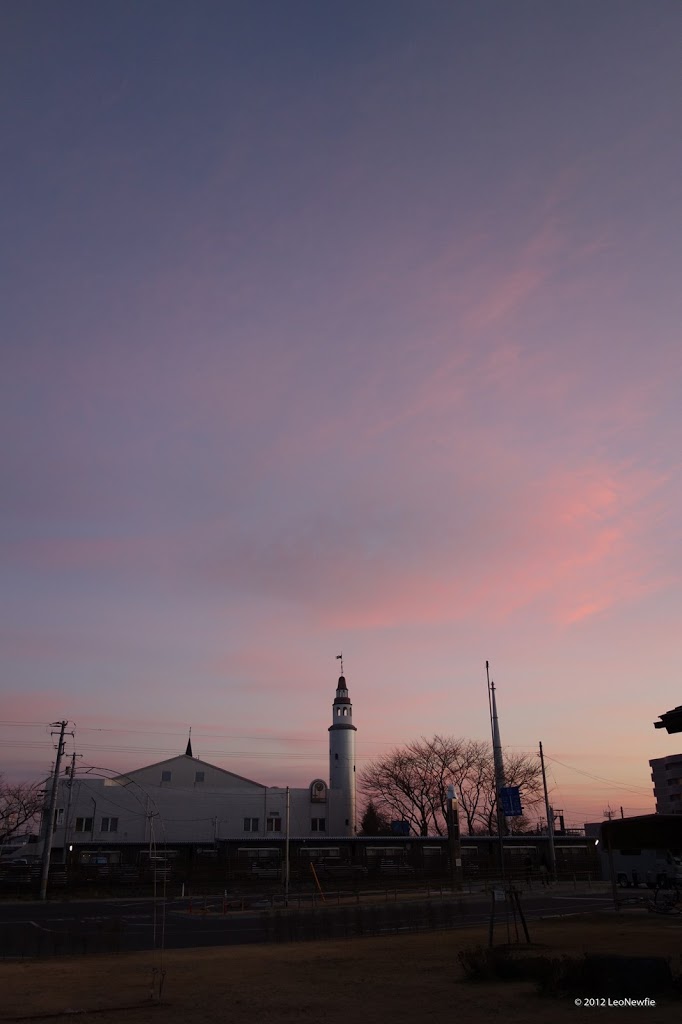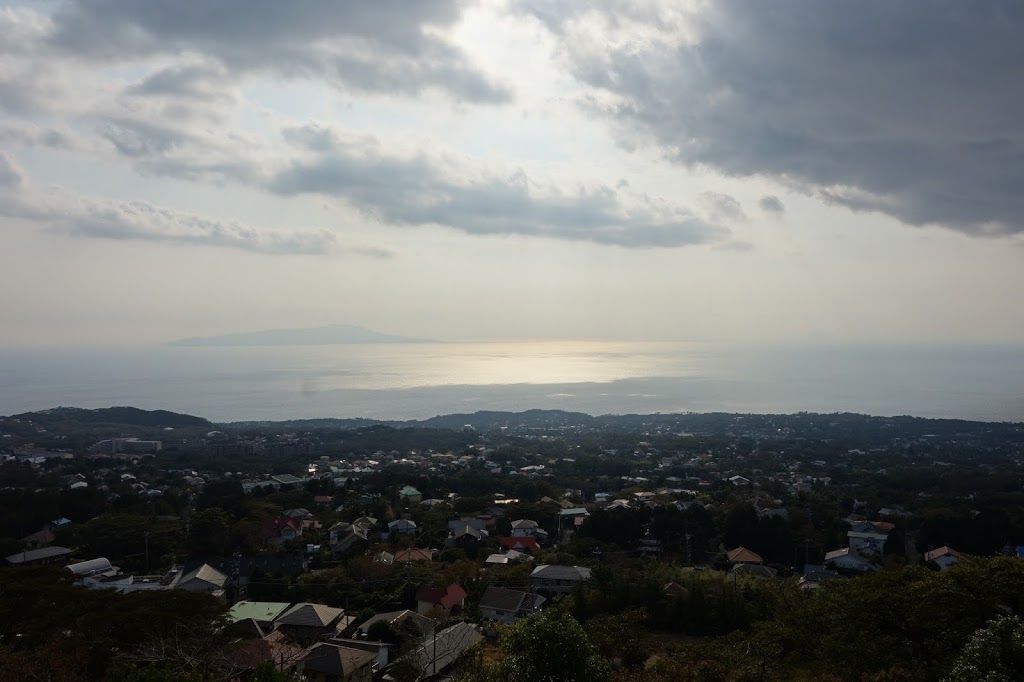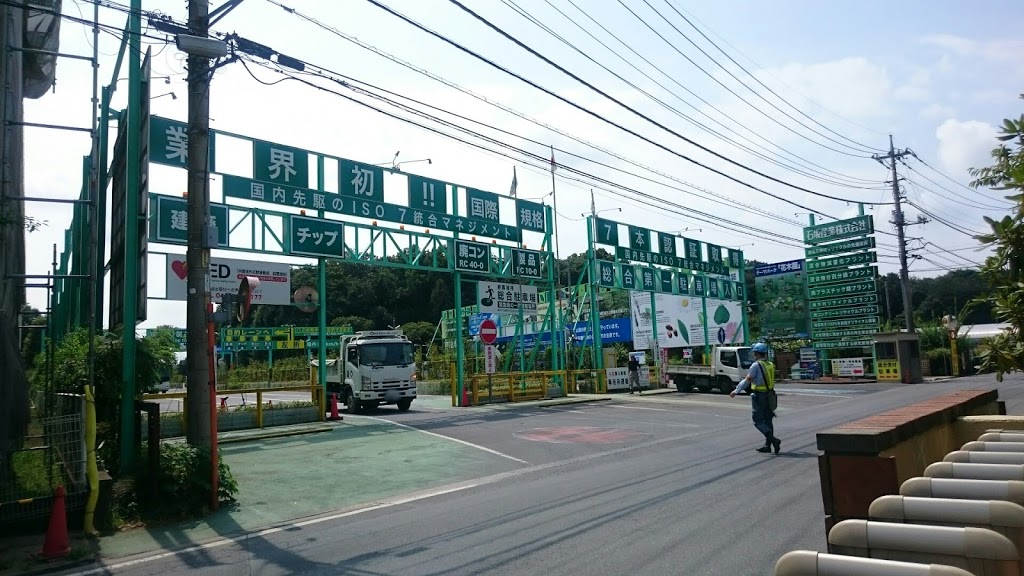東日本大震災から2年。先週末、久しぶりに震災ボランティアに参加した。
Two years have passed since the catastrophe on 11 Mar. 2011. I re-visited Fukushima as a volunteer in last weekend.
災害が起きてから時間が経つほど、ボランティアの役割やできる事は広がっていくんではなかろうか。離れた場所から被災地に入る場合は、現地での作業はもちろんだけれど、帰ってからその経験や想いを共有することが、より大事になってくると思う。
The longer the time has passed since a disaster, the broader roles and capabilities of volunteers. I think that not only on-site activities, but also sharing of that experiences and feelings after coming back is getting more important.
海外や、国内でも九州地方の人々は、地震の際にピクリとも揺れを感じることはなく、支援だ復興だといわれても実感が湧きにくいのは当然だろう。それでも作業を共にしてくれる人がいるのを忘れてはならないが…。
そして首都圏に暮らす人々の多くは、直接的な被害は免れていても、震災後しばらくは計画停電を経験したり、自分も何かしなければという衝動に駆られたりして、意識の中で震災が大きなウェートを占めていたはず。ただそれも時間の経過とともに徐々に薄れて、2年も経てば、日常の意識からは飛んでしまっているというのが実状だと思う。自分もそうだった。。。
Even in Japan, many people are forgetting with time about “What Happened”, the earthquake, the tsunami, the nuclear accident, and all the following chain of events and people’s actions. I was not an exception.
だからこそボランティアとして被災地に足を踏み入れたからには、復興のためにも、今後の災害に備えるためにも、感じたことをシェアしておきたい。
I believe that to share the experience can be a brake against the memory fading. For them, for us, and for everyone.
 |
| 早朝の南相馬 道の駅より (Morning glow of Minami-soma) |
震災の2ヵ月後に、所属するゴスペルクワイヤのメンバーで歌とポトフを届けに、いわき市の避難所を訪れた。その際に、単発で済ませるのではなく、長い目で活動を続けていかなくてはと感じたのを覚えていたけれど、その必要性は想像以上だった。
今回の行き先は特に風評被害が深刻(※)という福島県の南相馬市。作業を共にしたのは、職場つながりの有志(といっても初対面の方ばかり)50人強。南相馬は、長い間入れずで、未だに昼間しか滞在が許されない原発20km圏内ということもあってか、他の場所に比べてボランティアの数も少ないし、見た目でも明らかに復興の進みが遅い。
This time, I went to Minami-soma city in Fukushima with job-related volunteers of 50-plus members.
南相馬に限った話ではないけれど、地震や津波で瓦礫に埋もれた家や田畑、きれいに片付けようにも、一人はおろか家族で協力したとしてもどうにかできるような規模ではなく、お手上げ状態。そんな場所がまだ沢山あって、多くのボランティアを必要としている。
Because of the slow pace of reconstructions, not only Minami-soma city, but many other areas in Fukushima also require a number of volunteers.
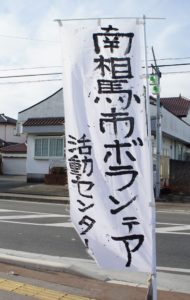 |
| ボランテア …違和感ない Outstanding flag of the volunteer center |
今回依頼された作業は、ざっくり100m程の長さの田んぼ沿いの側溝を掘って、本来の役割を取り戻すこと。作業前の写真アップは控えるが、道路と田んぼの境目の側溝には、泥や瓦礫がびっしりと詰まって、どこが側溝なのかも分からない。
そんな状態から地道に手やスコップで掘っていくと、木材や岩、冬眠していた多くのカエルたちやカニ以外に、食器や着るものなど、生活感を感じられるものも出てきて、複雑な気持ちに。。。側溝がしっかり姿を見せて、水がスムーズに流れるようになるまで、ほぼ丸一日。
What we’ve done is to excavate an about-100m-long side ditch along a rice paddy. Before we start to dig, it was difficult to judge where is the ditch where we’re supposed to excavate, because the ditch was clogged up and covered with mud and small rubble.
Digging and scooping up little by little, we met up with many dormant frogs. The work itself is fun, but sometimes, appeared goods with live-in feel like clothes or dishes out of mud bring us mixed emotions. It takes a full day to scoop up all the mud from the ditch and to make it work as a ditch.
側溝掘りは、体力的にはかなりキツい方の作業だと思う。でも掘り進むごとに見違えるほどきれいになっていくし、最後に水を入れると、サーッとスムーズに流れてその水面の煌めきに感動すらできる…作業後の達成感は格別なものだ。
Although I think scooping out mud from a ditch is fairly tough work in a physical way, the amount of effort is steadily transformed into visible results. So, its sense of achievement is great!
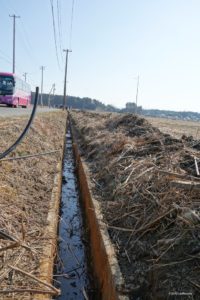 |
| 側溝が側溝として蘇る (Fainally, a ditch appears…) |
今や東京に居ながらにしてできることはいくらでもあるし、被災地支援するのに、必ずしも現地入りする必要はない。とはいえ被災地でのボランティアも、以前に比べるとかなり敷居が下がっているように思う。
震災直後と違って、今では被災地各所にボランティアセンターが設置され、そこでその地域のボランティアをお願いしたい人々から案件を集めて、その中から優先度や規模、作業内容などを考慮の上で、各ボランティアに対してマッチングを行ってくれる。以前のように個々の避難所などに直接ニーズを問い合わせて行ってはみたものの、実際に必要とされてるものが正確に伝わってなかったり…なんてことはまず起きないし、個人でもボラセンに連絡するだけで、気軽に身の丈にあった有意義な支援活動ができるようになっている。
久々に被災地での活動に参加できて、本当によかったと思う。今回は震災直後参加した支援活動では思い至らなかったことをひとつ感じた。
The after-two-years activities in Fukushima was quite fruitful in some ways. And there’s a thing I’d like to share here. It is what I didn’t realize through a previous volunteer activity in May 2011.
1対1で行う場合は別かもしれないが、ボランティア活動をするにあたって、人からの感謝やお褒めの言葉など、無形のものでも何らかの見返りを期待したり、それらをモチベーションにすべきではない。お礼を言われなければ満足できない、では続かないし、顔が見えるとは限らない誰かへの思いやり、もちろん必要なものだが、それだけでは時間とお金と知恵と力を費やすだけの動機としては正直弱い。これも気持ちが長くは続いていかない。
When we participate volunteer activities, even if it’s an intangible thing like a word “Thank You!” or a complement from others, something in return from local people is not appropriate as an only motivation for the participation.
As reasons, if we can’t satisfy without appreciation from others, it’s difficult to keep the motivation for continuing the activities. Additionally, a kindness for someone who might not see his/her face is of course important and is must-have item. However, it’s not strong enough as a motivation for activities that we spend time, money, wisdom and power into them.
あくまで、色々な作業を皆で協力して進めること自体を楽しみ、東北の、ひいては日本の復興に少しでも寄与していることと、それによってできた、利害を伴わない繋がりや絆に大きな喜びを感じるというのが、あるべき姿だと思った。
Volunteers including me enjoy team-play of various activities themselves. Then, we feel the joy of contribution for the reconstruction, and joy of the tie made through the activities. I believe that these are the main motivations, and this is the way volunteers hopefully always be.
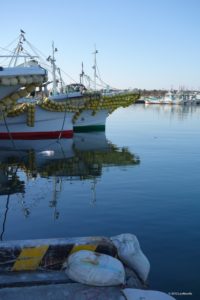 |
| 相馬市尾浜の港にて (port in Soma city ) |
※放射線量についてメモ
出発してから、作業を終えて宿に帰るまでの約30時間の蓄積線量が約2μSv。東京でのここ最近の時間毎の空間放射線量0.05μSvの30時間分が約1.5μSvなので、少し高めといえるかもしれないけれど、飛行機での東京-NY間往復で受ける線量が190μSvということを考えれば、個人的には気になるほどの差ではなかった。
— Memo for radiation dose —–
The accumulated dose of 30 hours, from going into a 20km radius of the ex-nuclear power plant to going out from there (including one-day activity) was approx. 2μSv. Then, that (same duration) of Tokyo in these days is approx. 1.5μSv. It means it’s true that the value is slightly higher than Tokyo area. But, if we think of accumulated exposed dose of return flight between Tokyo and New York, which is approx. 190μSv, the 0.5μSv difference is too small to care about for me personally.
最後に:
今回はボランティア作業に加えて、幸運にも、南相馬の中高生が集まって結成された、MJCこと南相馬ジュニアコーラスアンサンブルの皆さんの歌を聴かせてもらえる機会に恵まれた。
ちなみに、「南相馬ジュニアコーラス」というのは後から付いた呼び名で、活動拠点の旧酒蔵を復元した場所の名前から、「銘醸館コーラス」というのが本来のMJCの由来だそうな。
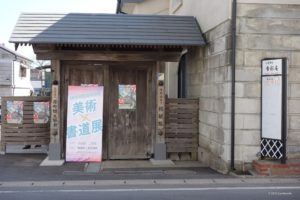 |
| 銘醸館では地域の高校生の作品展も開かれていた |
